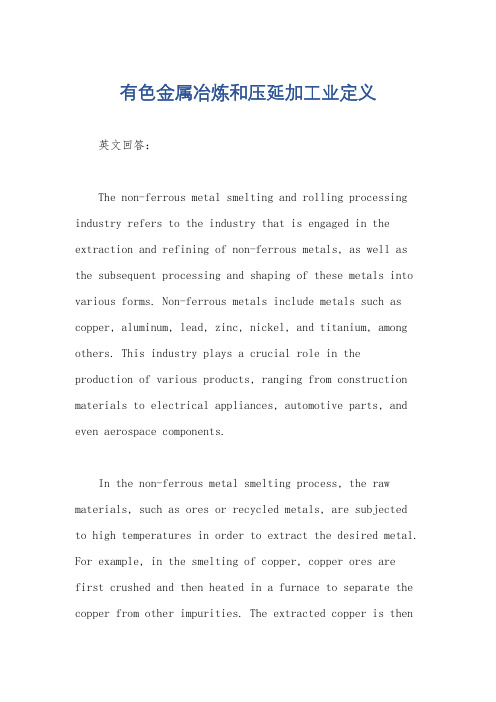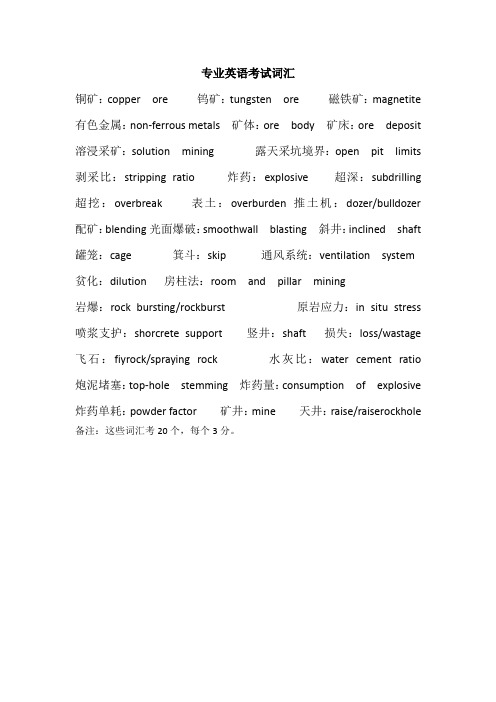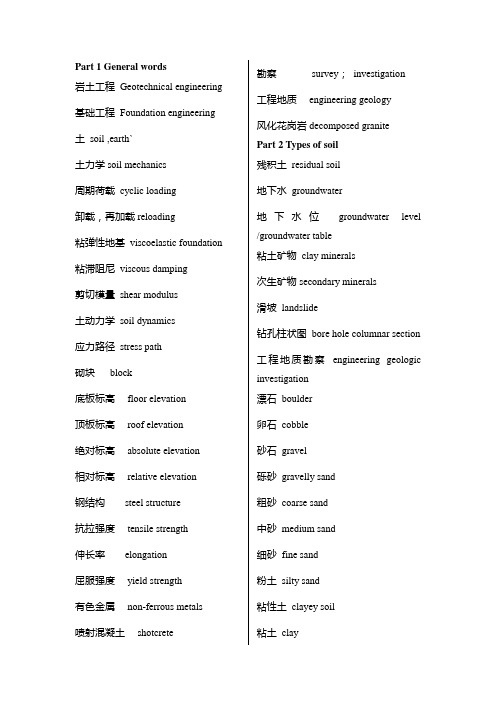有色金属诠释(non-ferrous metals)
有色金属国内贸易业务流程

有色金属国内贸易业务流程
英文回答:
The domestic trade business process of non-ferrous metals involves various steps and processes, ensuring the efficient and effective flow of non-ferrous metals within the domestic market. Here's an overview of the key steps in the domestic trade business process of non-ferrous metals:
1. Sourcing: The process begins with the identification and procurement of non-ferrous metals from various sources, such as mines, smelters, and refineries. Producers, suppliers, and traders play a crucial role in sourcing the required quantities and qualities of non-ferrous metals.
2. Logistics and Transportation: Once the non-ferrous metals are sourced, they need to be transported from the source to the end-user's location. This involves careful planning and coordination of logistics and transportation, including selecting the appropriate transportation modes
有色金属冶金学锌(一)

2
湿法冶金的原料,按矿物特性可分为: 自然金属矿物:铜、金、银矿,经还原焙烧
的镍矿、合金废料等 硫化矿物:铜、镍、钴、锌的硫化矿,包括
造锍熔炼产物—锍 氧化矿物:铜、镍氧化矿,包括经氧化或硫
酸化焙烧后的铜、锌焙砂,钴黄铁矿烧渣, 以及氧化烟尘,转炉渣等 砷化矿:砷钴矿,包括黄渣
(2) 使精矿中的硫氧化变成 SO2,产出有足够 浓度的二氧化硫烟气,以便制取硫酸。
25
火法炼锌的焙烧是完全的氧化焙烧(死焙烧)。 这是因为火法冶炼是在强还原性气氛中使氧 化锌被一氧化碳还原成金属锌,在现有工艺 条件下硫化锌是不能被还原成金属锌的。
湿法炼锌厂的焙烧实际也是氧化焙烧。但在 焙砂中除了得到氧化锌外,还要保留少量的 硫酸盐,以补偿电解和浸出循环系统中硫酸 的损失 。
26
锌精矿焙烧的理论基础 硫化锌精矿焙烧时发生的主要反应为:
同时还形成部分碱式硫酸锌ZnO·2ZnSO4。 另外,还有可能直接生成金属锌:
27
28
焙烧时锌精矿中各组分的行为: 硫化锌。其反应如下
因此,硫化锌焙烧的结果可形成氧化锌或硫酸 锌。通过调节焙烧温度和气相成分,就可以在 焙砂中获得所需要的氧化物或硫酸盐。
13
Leabharlann Baidu
溶剂萃取
萃取:利用物质在互不相溶的两种液体中 的溶解度的差异,来实现物质分离的一种 方法。
有色金属及其合金课件

谢谢观赏
zinc alloy
1.镁及镁合金
镁密度为1.74g/cm³ ,熔点为650℃。 其差的耐蚀性和低的抗氧化性使镁作为结构材料的应用比例不高。 近年来作为新一代轻合金结构材料,镁合金得到了大力开发。 两类镁合金: 含铝的镁合金。 具有高的强度和塑性,良好的耐大气腐蚀性 含锆的镁合金。添加稀土元素适于300℃下环境使用,添加 锌元素有良好的强度与塑性。
•
来自百度文库
合金元素依对钛合金相图的影响可以分3类: 中性元素(锆、锡等)、α稳定化元素(铝、氧、 氮和碳等)和β稳定化元素(同晶型有钒、铌等; 共析型有铁、锰、铜等)。
与钢相似,同素异构转变是钛合金的组织、性能多样性的基础。
钛合金退火组织可分为α型(TA)、β型(TB)和α+β 型(TC)。
美F-22战机约36%重量的零件用 钛合金制造
2.70 画心立方 8.94 画心立方 4.51 密排六方 7.14 密排六方 1.74 密排六方 7.87 体心立方
力学性能:比强度高(σ /d),高温强度好; 例如:Al、Ti;用于航空、航天;
Ni基合金工作温度800-1000℃、Mo基1300℃
物理性能:导电性好:Ag、Cu、Al; 磁性材料:Co; 超导材料;防辐射材料:Pb
纯铜组织 按主加合金元素分类:
纯铜 导电及导热性能好, 抗大气腐蚀性好,塑性高,加工性 好, 无磁性冲击无火花等。 黄铜(Cu-Zn) 黄铜合金依成分其 力学和成形、加工性、铸造性、腐 蚀性等各异。 青铜(Cu-Sn)是人类使用历史最 久的金属材料,Zn的加入明显地提 高了铜的强度,并使其塑性得到改 善,抗腐蚀性增强。 白铜(Cu-Ni) 有优异的耐蚀性和 高的电阻,故可用作苛刻腐蚀条件 下工作的零部件和电阻器的材料。
有色金属合金 英语

有色金属合金英语
English Answer:
Non-ferrous metal alloys are metallic materials formed by combining two or more non-ferrous metals. They are typically characterized by their strength, corrosion resistance, ductility, and electrical and thermal conductivity. Non-ferrous metal alloys are widely used in various industries, including automotive, aerospace, electronics, and construction. Some common types of non-ferrous metal alloys include:
1. Aluminum Alloys: Aluminum alloys are lightweight and strong, making them ideal for use in aircraft, automobiles, and construction. They are also corrosion-resistant and can be easily fabricated and recycled.
2. Copper Alloys: Copper alloys, such as brass and bronze, are known for their high electrical and thermal conductivity. They are often used in electrical wiring,
关于金属材料英语作文

关于金属材料英语作文
Title: Exploring the Wonders of Metal Materials。
Introduction:
Metal materials have played a crucial role in human civilization for millennia, serving as the backbone of various industries and technological advancements. From ancient tools to modern skyscrapers, the versatility and strength of metals have shaped the world we live in today.
Definition and Classification:
Metal materials are chemical elements or alloys characterized by their high electrical conductivity, luster, malleability, and ductility. They can be classified into ferrous metals (containing iron) and non-ferrous metals (without iron). Ferrous metals include steel and cast iron, while non-ferrous metals encompass aluminum, copper, and titanium, among others.
黑金属和有色金属Ferrous and Non-Ferrous Metals

lower the melting point alter thermal and electrical properties make a material harder for cutting purposes improve resistance to corrosion help metal to flow better into a cast.
© Boardworks Ltd 2005
Industrial processes
Milling machines are used to remove thin layers from a billet (block of material) which is clamped to the bed (base) of the machine. The material is fed past a cutting tool which has many sharp teeth and can remove material quickly. When manufacturers want to make cylindrical products, they use a centre lathe. Metals and plastics can be used on this machine. The work is held in a chuck and a cutting tool is moved towards the work while being held in a tool holder, mounted on the tool post.
南京邮电大学 材料化学简答题(重点)

1 What is fatigue?(材料的疲劳)
Answer: Fatigue refers to the phenomenon that materials first form permanent damage at some points, and then form crakes or the crakes are further extended until complete rupture under cyclic stress (tension, compression, shear, bending, etc.).
2Blank metals(黑色金属): refers to Fe, Cr, Mn and their alloys, mainly are Fe and its alloy.
3Non-ferrous metals(有色金属): refers to metals except iron, chromium, manganese and their alloys.
4Austenite(奥氏体): interstitial solid solution formed by carbon dissolves in γ-Fe, it remains face-centered cubic lattice of γ-Fe, the grain boundary is relatively straight, and is regular polygon.
5 Martensite(马氏体): supersaturated solid solution formed by the carbon dissolves in α-Fe, the crystal structure is body-centered tetragonal structure, it can be obtained by accelerated cooling the high-carbon steel.
金属材料 专业英语

金属材料专业英语
英文回答:
Metallic Materials.
Metallic materials are composed of metal atoms arranged in a highly ordered crystalline lattice structure. This atomic arrangement gives metals their characteristic properties, including their high strength, ductility, and thermal and electrical conductivity.
Metals are classified into two main categories: ferrous and non-ferrous. Ferrous metals are primarily composed of iron, while non-ferrous metals are composed of other elements, such as aluminum, copper, and zinc.
Ferrous metals are used in a wide variety of applications, including construction, automotive manufacturing, and shipbuilding. Non-ferrous metals are also used in a wide range of applications, including
有色金属冶炼和压延加工业定义

有色金属冶炼和压延加工业定义英文回答:
The non-ferrous metal smelting and rolling processing industry refers to the industry that is engaged in the extraction and refining of non-ferrous metals, as well as the subsequent processing and shaping of these metals into various forms. Non-ferrous metals include metals such as copper, aluminum, lead, zinc, nickel, and titanium, among others. This industry plays a crucial role in the production of various products, ranging from construction materials to electrical appliances, automotive parts, and even aerospace components.
In the non-ferrous metal smelting process, the raw materials, such as ores or recycled metals, are subjected to high temperatures in order to extract the desired metal. For example, in the smelting of copper, copper ores are
有色金属项目介绍与总结

有色金属项目介绍与总结
在现代工业中,有色金属(Non-ferrous metals)广泛应用于各个领域,包括电子、航空航天、建筑等。本文将介绍有色金属项目的基本概念以及对其进行总结。
一、有色金属项目介绍
有色金属是指除了铁以外的所有金属材料。通常,有色金属具有良好的导电性、导热性和良好的腐蚀抗性。在有色金属项目中,常见的有铜、铝、镁、锌等。以下将分别对这些有色金属进行介绍。
1. 铜
铜是最早被使用和开发的有色金属之一。它具有优良的导电性和导热性,广泛应用于电线、电缆、管道、电子器件等领域。铜还可以合金化,提高强度和耐蚀性。
2. 铝
铝是另一个重要的有色金属。它具有较低的密度和良好的导电性和导热性,广泛应用于交通工具、建筑、包装等领域。铝的使用可以减轻重量,提高节能效果。
3. 镁
镁是一种轻质金属,密度较低。它具有良好的强度和刚性,多用于航空航天、汽车制造和电子器件等领域。镁合金还具有吸能性能,在汽车碰撞中能起到良好的保护作用。
4. 锌
锌是一种常见的金属,具有良好的防腐蚀性能。它广泛应用于钢铁防腐、电池制造、建筑材料等领域。锌合金也被用于压铸件和表面涂层处理。
二、有色金属项目总结
有色金属项目具有以下几个优点:
1. 优良的物理性能
有色金属具有良好的导电性、导热性和可塑性。这些特性使得有色金属在电子、通信等领域中广泛应用。
2. 良好的耐腐蚀性
有色金属在大多数环境条件下都具有较好的耐腐蚀性能,可以长期使用而不会受到严重损害。这一特点使得有色金属在建筑、输油管道等领域中得到广泛应用。
3. 可持续性利用
专业英语考试词汇

专业英语考试词汇
铜矿:copper ore 钨矿:tungsten ore 磁铁矿:magnetite 有色金属:non-ferrous metals 矿体:ore body 矿床:ore deposit 溶浸采矿:solution mining 露天采坑境界:open pit limits 剥采比:stripping ratio 炸药:explosive 超深:subdrilling 超挖:overbreak 表土:overburden 推土机:dozer/bulldozer 配矿:blending光面爆破:smoothwall blasting 斜井:inclined shaft 罐笼:cage 箕斗:skip 通风系统:ventilation system 贫化:dilution 房柱法:room and pillar mining
岩爆:rock bursting/rockburst 原岩应力:in situ stress 喷浆支护:shorcrete support 竖井:shaft 损失:loss/wastage 飞石:fiyrock/spraying rock 水灰比:water cement ratio 炮泥堵塞:top-hole stemming 炸药量:consumption of explosive 炸药单耗:powder factor 矿井:mine 天井:raise/raiserockhole 备注:这些词汇考20个,每个3分。
有色金属英语

Non-ferrous metals: [Metallurgy] nonferrous metal, nonferrous metal, also known as a narrow non-ferrous metals, all metals are collectively referred to as iron, manganese, chromium outside. Generalized non-ferrous metals also include non-ferrous alloys. A ferrous alloy is an alloy of non-ferrous metal substrate (typically greater than 50%), by adding one or several other elements constituted.
有色金属:[Metallurgy]nonferrous metal,狭义的有色金属又称非铁金属,是铁、锰、铬以外的所有金属的统称。广义的有色金属还包括有色合金。有色合金是以一种有色金属为基体(通常大于50%),加入一种或几种其他元素而构成的合金。
Usually refers to the removal of non-ferrous iron (sometimes also remove manganese and chromium) for all metals and iron-based alloys outside. Heavy metals can be divided into non-ferrous metal (such as copper, lead, zinc), light metals (such as aluminum, magnesium), a noble metal (such as gold, silver, platinum), rare metals (such as tungsten, molybdenum, germanium, lithium, lanthanum, uranium).
有色金属冶金学铜(三)

12
► 第二周期开始时,并不会立即出现金属铜相。从图 3-46可以看出,Cu2S可溶解少量金属铜(约10 %)。吹炼过程中随着Cu2S的氧化,熔体中含铜量 逐渐增加,当熔体中含铜量增加到82%以上时(相 当于硫化亚铜中溶解有10%的金属铜),熔体即分 成两层。上层是含有少量金属铜的硫化亚铜,下层 是含有少量硫化亚铜(接近9%)的金属铜。继续吹 炼时,下层金属铜量逐渐增加,上层硫化亚铜量逐 渐减少。这时应适当转动炉子,缩小风口浸入熔体 的深度,使空气送入上层硫化亚铜熔体中。当熔体 中硫化亚铜含量降低到等于溶解度曲线C点的组成 时,上层硫化亚铜消失,熔体成为溶解有少量硫化 亚铜的均一金属铜相。继续吹炼时溶解在金属铜中 的硫化亚铜氧化。这时炉口烟量显著减少,送风压 力增加(由于熔体阻力变大),风量变小,很决就到 达第二周期终点,即全部硫化亚铜氧化生成粗铜。 实践中,粗铜含硫可降至0.003%。
造锍熔炼过程的炉渣含铜量低于0.5%
吹炼过程的炉渣含铜2%左右
9
(2)锍中各组分在吹炼过程中的行为
A、FeS。 FeS是锍的主要成分,可以氧化 成FeO 和Fe3O4;无SiO2存在时, Fe3O4 很难被FeS还原,而有SiO2存在时, Fe3O4 与FeS 和SiO2反应生成2FeS ·SiO2的趋势 大大增加。
隧道专业英语

Part 1 General words
岩土工程Geotechnical engineering
基础工程Foundation engineering
土soil ,earth`
土力学soil mechanics
周期荷载cyclic loading
卸载,再加载reloading
粘弹性地基viscoelastic foundation
粘滞阻尼viscous damping
剪切模量shear modulus
土动力学soil dynamics
应力路径stress path
砌块block
底板标高floor elevation
顶板标高roof elevation
绝对标高absolute elevation
相对标高relative elevation
钢结构steel structure
抗拉强度tensile strength
伸长率elongation
屈服强度yield strength
有色金属non-ferrous metals
喷射混凝土shotcrete
勘察survey;investigation
工程地质engineering geology
风化花岗岩 decomposed granite
Part 2 Types of soil
残积土residual soil
地下水groundwater
地下水位groundwater level /groundwater table
粘土矿物clay minerals
次生矿物secondary minerals
滑坡landslide
钻孔柱状图bore hole columnar section 工程地质勘察engineering geologic investigation
有色金属冶炼 生产流程

有色金属冶炼生产流程
Melting and smelting are two key processes in the production of non-ferrous metals. Melting is the initial step in the process, which involves heating the raw materials to a high temperature to turn them into a liquid form. This liquid metal is then transferred to a smelting furnace for further refining. Smelting, on the other hand, is the process of extracting the desired metal from the raw material by removing impurities and other unwanted elements. Both processes are crucial in the production of high-quality non-ferrous metals.
在有色金属冶炼生产流程中,熔炼和冶炼是两个关键的步骤。熔炼是这个过程中的初始步骤,它涉及将原材料加热到高温以将其转化为液态形式。这种液态金属然后被转移到冶炼炉中进行进一步的精炼。另一方面,冶炼是从原材料中提取所需金属的过程,通过去除杂质和其他不需要的元素。这两个过程对于生产高质量的有色金属至关重要。
- 1、下载文档前请自行甄别文档内容的完整性,平台不提供额外的编辑、内容补充、找答案等附加服务。
- 2、"仅部分预览"的文档,不可在线预览部分如存在完整性等问题,可反馈申请退款(可完整预览的文档不适用该条件!)。
- 3、如文档侵犯您的权益,请联系客服反馈,我们会尽快为您处理(人工客服工作时间:9:00-18:30)。
有色金属诠释(non-ferrous metals)
摘要: 有色金属non-ferrous metal,狭义的有色金属又称非铁金属,是铁、锰、铬以外的所有金属的统称。广义的有色金属还包括有色合金。有色合金是以一种有色金属为基体(通常大于50%),加入一种或几种其他元素而构成的合金 ...
有色金属non-ferrous metal,狭义的有色金属又称非铁金属,是铁、锰、铬以外的所有金属的统称。广义的有色金属还包括有色合金。有色合金是以一种有色金属为基体(通常大于50%),加入一种或几种其他元素而构成的合金。
有色金属[Metallurgy] nonferrous metals 简介:
定义:狭义的有色金属又称非铁金属,是铁、锰、铬以外的所有金属的统称。
广义的有色金属还包括有色合金,有色合金是以一种有色金属为基体(通常大于50%),加入一种或几种其他元素而构成的合金。
有色金属通常指除去铁(有时也除去锰和铬)和铁基合金以外的所有金属。有色金属可分为四类:
1、重金属:一般密度在4.5g/cm3以上,如铜、铅、锌等;
2、轻金属:密度小(0.53~4.5g/cm3),化学性质活泼,如铝、镁等;
3、贵金属:地壳中含量少,提取困难,价格较高,密度大,化学性质稳定,如金、银、铂等;
4、稀有金属:如钨、钼、锗、锂、镧、铀等。
详细信息:
有色金属是指铁、铬、锰三种金属以外所有的金属。中国在1958年,将铁、铬、锰列入黑色金属;并将铁、铬、锰以外的64种金属列入有色金属。这64种有色金属包括:铝有色金属分布、镁、钾、钠、钙、锶、钡、铜、铅、锌、锡、钴、镍、锑、汞、镉、铋、金、银、铂、钌、铑、钯、锇、铱、铍、锂、铷、铯、钛、锆、铪、钒、铌、钽、钨、钼、镓、铟、铊、锗、铼、镧、铈、镨、钕、钐、铕、钆、铽、镝、钬、铒、铥、镱、镥、钪、钇、硅、硼、硒、碲、砷、钍。
种类面积:
有色金属表面积也是非常重要的,有色金属的比表面积检测数据只有采用BET方法检测出来的结果才是真实可靠的,国内目前有很多仪器只能做直接对比法的检测,现在国内也被淘汰了。目前国内外比表面积测试统一采用多点BET 法,国内外制定出来的比表面积测定标准都是以BET测试方法为基础的,请参看中国国家标准(GB/T 19587-2004)-气体吸附BET原理测定固态物质比表面积的方法。
比表面积检测其实是比较耗费时间的工作,由于样品吸附能力的不同,有些样品的测试可能需要耗费一整天的时间,如果测试过程没有实现完全自动化,那测试人员就时刻都不能离开,并且要高度集中,观察仪表盘,操控旋钮,稍不留神就会导致测试过程的失败,这会浪费测试人员很多的宝贵时间。真正完全自动化智能化比表面积测试仪产品,才符合测试仪器行业的国际标准,同类国际产品全部是完全自动化的,人工操作的仪器国外早已经淘汰。真正完全自动化智能化比表面积分析仪产品,将测试人员从重复的机械式操作中解放出来,大大降低了他们的工作强度,培训简单,提高了工作效率。真正完全自动化智能化比表面积测定仪产品,大大降低了人为操作导致的误差,提高测试精度。F-Sorb 2400比表面积测试仪是真正能够实现BET法检测功能的仪器(兼备直接对比法),
更重要的F-Sorb 2400比表面积测试仪是迄今为止国内唯一完全自动化智能化的比表面积检测设备,其测试结果与国际一致性很高,稳定性也很好,同时减少人为误差,提高测试结果精确性。比表面积检测需遵循相关标准、方法及理论,具体详细信息可以去相关网站中进一步了解。
发展简史:
在历史上,生产工具所用的材料不断改进,它与人类社会发展的关系十分密切。因此历史学家曾用器物的材质来标志历史时期,如石器时代、青铜器时代、铁器时代等。到17世纪末被人类明确认识和应用的有色金属共 8种。中华民族在这些有色金属的发现和生产方面有过重大的贡献(见冶金史)。进入18世纪后,科学技术的迅速发展,促进了许多新的有色金属元素的发现。上述的64种有色金属除在17世纪前已被认识应用的 8种外,在18世纪共发现13种。19世纪发现39种,进入20世纪,又发现4种。
特色:
有色合金的强度和硬度一般比纯金属高,电阻比纯金属大、电阻温度系数小,具有良好的综合机械性能。常用的有色合金有铝合金、铜合金、镁合金、镍合金、锡合金、钽合金、钛合金、锌合金、钼合金、锆合金等。
应用:
A 有色金属中的铜是人类最早使用的金属材料之一。现代,有色金属其合金已成为机械制造业、建筑业、电子工业、航空航天、核能利用等领域不可缺
少的结构材料和功能材料。
B 实际应用中,通常将有色金属分为5类:
1.轻金属。密度小于4500千克/立方米,如铝、镁、钾、钠、钙、锶、钡等。
2.重金属。密度大于4500千克/米3,如铜、镍、钴、铅、锌、锡、锑、铋、镉、汞等。
3.贵金属。价格比一般常用金属昂贵,地壳丰度低,提纯困难,如金、银及铂族金属。
4.半金属。性质价于金属和非金属之间,如硅、硒、碲、砷、硼等。
5.稀有金属。包括稀有轻金属,如锂、铷、铯等;
稀有难熔金属,如钛、锆、钼、钨等;
稀有分散金属,如镓、铟、锗、铊等;
稀土金属,如钪、钇、镧系金属;
放射性金属,如镭、钫、钋及阿系元素中的铀、钍等。
地位及作用:
有色金属是国民经济、人民日常生活及国防工业、科学技术发展必不可少的基础材料和重要的战略物资。农业现代化、工业现代化、国防和科学技术现代化都离不开有色金属。例如飞机、导弹、火箭、卫星、核潜艇等尖端武器以及原子能、电视、通讯、雷达、电子计算机等尖端技术所需的构件或部件大都是由有色金属中的轻金属和烯有金属制成的;此外,没有镍、钴、钨、钼、钒、铌等有色金属也就没有合金钢的生产。有色金属在某些用途(如电力工业等)上,使用量也是相当可观的。现在世界上许多国家,尤其是工业发达国家,竞相发展有色金属工业,增加有色金属的战略储备。
有色金属工业包括地质勘探、采矿、选矿、冶炼和加工等部门。矿石中有色金属含量一般都较低,为了得到1吨有色金属,往往要开采成百吨以至万吨以上的矿石。因此矿山是发展有色金属工业的重要基础。有色金属矿石中常是多种金属共生,因此必须合理提取和回收有用组分,做好综合利用,以便合理利用自然资源。许多种稀有金属、贵金属以及硫酸等化工产品,都是在处理有色金属矿石或中间产品以及矿渣、烟尘的过程中回收得到的。有色金属生产过程中通常产生大量废气、废水和废渣,其中含有多种有用组分,有时含有有毒物质,一些有色金属也具有毒性。因此,在生产有色金属的过程中,必须注意综合利用与环境保护。此外,与钢铁的生产相比,一般说来,有色金属生产需要的能量是比较多的。据统计,如从矿石生产每吨钢能耗以100计,镁为 1127,铝为767,镍为455,铜为352,锌为206。因此,在有色金属工业中,降低能耗问题非常突出。在有色金属的开采、选矿、冶炼、加工及再生回收过程中,有多种提取方法可资选用。就冶炼过程而言,通常分为火法冶金、湿法冶金和电冶金。火法冶金一般具有处理精矿能力大,能够利用硫化矿中硫的燃烧热,可以经济地回收贵金属、稀有金属等优点;但往往难以达到良好的环境保护。湿法冶金常用于处理多金属矿、低品位矿和难选矿;电冶金则适用于铝、镁、钠等活性较大的金属的生产。这些方法要针对所处理的矿物组成选择使用或组合使用。为了强化有色金属
